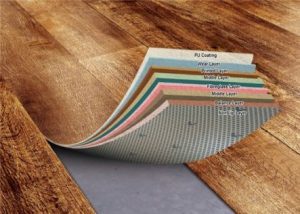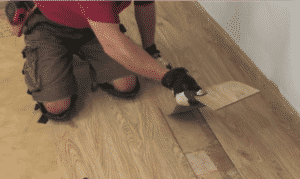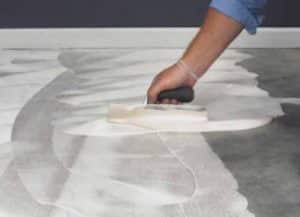If you are looking at getting loose lay vinyl flooring for your home, but you think to yourself… ‘Is it really loose lay? If it is loose lay, won’t my kids lift up the planks?’ These are all good questions so let us explain why they are called loose lay and about the different installation methods that can be used depending on your situation.
What is loose lay vinyl:
Individual vinyl plank floors have been around since the 1990s but, as with all products, they thought how can we make it better? In 2011, following many years of development, Karndean introduced LooseLay to the Australian market. Since then, many other manufactures have released their loose lay equivalents. What makes these products different from the previous 2-3mm vinyl planks was their extra thickness of 4.5-5.0mm, which also added to the weight of the product. Loose lay planks contain additional layers including a reinforcing layer for dimensional stability and most include a special non-slip backing.
With its extra weight, dimension stability, and special non-slip backing, loose lay vinyl planks could be installed as a true loose lay floor. While this is true, it has been found over the years that if the product is not tightly cut up to the perimeter walls or in larger areas particularly with high traffic, the loose lay planks may slightly migrate leaving some gapping. To combat this, additional installation methods were introduced using double-sided tape, pressure sensitive adhesive, hard set adhesive and two-part epoxy adhesives.
Installation Methods:
Installing without any tapes or adhesives can be done in smaller rooms or temporary areas where you may not want to leave any residue. If the planks are not cut in tight, the planks can migrate and leave you with some gapping.
Double-sided tape can be installed around the perimeter of a room and will hold the perimeter planks in place, which is handy if they are not cut tight enough to the walls. In larger rooms, the double-sided tape can be installed across the length and width of the room a couple of time in a grid layout to minimise plank migration.
Pressure sensitive adhesive (also known as PS for short) can be applied to the entire subfloor where the loose lay vinyl planks are to be installed. PS is an adhesive that once dry maintains a tacky surface similar to tape. This is usually installed using a trowel to get a good layer of PS down, or alternatively it can be rolled on, but this will only apply a thinner layer of PS. This method will still allow you to easily replace a plank if damaged without having to reapply more adhesive.
Acrylic adhesive is used to hard set loose lay vinyl planks to the floor and is the same adhesive used with the previous non-loose lay vinyl planks. This is the typical method used by professional installers as it minimises possible future issue which the installer would have to return to fix and also in commercial areas. With this method, you need to get it right the first time, as once the adhesive has set the planks cannot be easily removed. Replace requires the plank to be removed cut into smaller strips to remove, and then scaping of the remaining adhesive from the floor.
Two-part epoxy adhesive is a hard-set adhesive which can tolerate heat and moisture such as in area’s where the sun shines directly on the floor or in bathrooms. While this is the installation method that will give the least issues in all installation areas, it is also the trickiest to do as you need to mix the adhesive correctly, you only have a certain time before the adhesive sets, and once the adhesive has set it is really hard to uplift the planks.
Recap on the options:
- True loose lay (no tape or adhesive) is suitable for small or temporary areas.
- Double-sided tape is a quick and easy method for the DIYer’s.
- PS adhesive is a method for the DIYer who would like to reduce the chance of the floor migrating or children lifting up the planks.
- Hard set acrylic adhesive is used by professional installers or in commercial areas.
- Two-part epoxy adhesive is for heat exposed (direct sunlight) and high wet areas (bathrooms).
Conclusion:
So the answer to the question ‘Is it really loose lay?’ is yes, but depending on your situation you might prefer one of the other tape or adhesive methods. If you are worried about lifting of the planks, the natural weight of the planks makes it hard for children or a vacuum cleaner to lift. If you are still unsure which installation method is best for you, one of our expert flooring consultants will be able to discuss your situation further and advise which one would be best suited for you.



